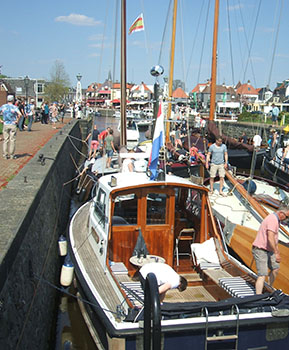Every once in a while, it is good to have your basic assumptions challenged. If you see a waterfall, you expect to see water leaping off of some high point into a pool below.

The Netherlands may be the only place on earth where boats need be lowered as they leave the sea. Photo by Captain Ray
By Captain Ray
Published: August, 2016
Every once in a while, it is good to have your basic assumptions challenged. If you see a waterfall, you expect to see water leaping off of some high point into a pool below. After all, what else can the water do when it arrives at the edge of the cliff?
But, many years ago I was at a place there the water didn’t fall as it went over the cliff. Instead, it rose! There is a logical explanation, of course: wind. In this case, the very consistent northeast trade winds that blow across the Hawai’ian Islands. As this wind strikes the Pali (a more than 1000-foot-high cliff on the northeast side of Oahu), the wind flows up the face of the cliff, carrying the water from the stream with it. However, the phenomenon was no less wondrous once I learned the physics behind it.
On a visit to Europe last May, I had another of those reorientations to the wonders and surprises of our planet. I was in the town of Lemmer, in Friesland, the northernmost province of the Netherlands. The town is located on the IJsselmeer. This body of water was called the Zuider Zee (or South Sea) until 1932, when the Netherlands diked it off from the Noord Zee (North Sea) and turned it into a large freshwater lake. We had come to watch a skûtsje (Dutch sailing barge) race and enjoy a warm, sunny spring day. There was also a festival of some sort in the town and, after the race was over, all the boats began to crowd into the Lemster Sluis, the lock connecting the IJsselmeer with the Lemmer town waterfront basin.
It can be quite entertaining when many boats are trying to maneuver into a small space. There tends to be quite a bit of jockeying for position, mostly good natured shouting, and some pushing and shoving of boats—called “fending off” in sailor talk. We stood at the edge of the lock to watch the fun. This sluis however, was under the control of a very efficient (and very firm) lock mistress. Through a series of unambiguous verbal commands and unmistakable gestures, she was very much in charge. Not so much bringing order to chaos as preventing chaos in the first place. So orderly. So very Dutch.
When the lock was filled to capacity and the gate closed, the lock mistress picked up a long pole. Suspended by a cord from the end of the pole was a klompen (a wooden shoe). Using this uniquely Dutch technique, she reached out to each boat in the lock chamber and collected the required toll.
I have been through many locks: the Panama Canal on an aircraft carrier (I wasn’t driving); the Ballard Locks in Seattle, which connect Lake Union with Puget Sound; as well as locks on the Rhine and Danube rivers. The concept of lifting vessels above sea level (in the case of the Panama Canal, 85 feet) has always fascinated me. In Europe these canals and locks connect the continent’s major river systems (the Rhine, the Danube, the Seine, the Rhone, the Loire, etc.) allowing unrestricted water transport from Rotterdam and Amsterdam on the North Sea to the Black and Mediterranean Seas.
You may be wondering what this has to do with challenging preconceived assumptions. Well, at the Lemster Sluis, once the tolls were collected and the water began to flow between the chambers, the vessels in the lock did not rise. Based on my experience with locks, I expected a lock leading inland from the sea to raise boats. But almost half of Friesland is below sea level. The town of Lemmer and its waterfront basin are about 1.5 meters below sea level. The Netherlands may be the only place on earth where boats need be lowered as they leave the sea and move inland.
There is a saying: “God made the earth, but the Dutch made Holland!” Indeed.
Ray Wichmann is a US SAILING-certified Ocean Passagemaking Instructor, a US SAILING Master Instructor Trainer, and a member of US SAILING’s National Faculty. He holds a 100-Ton Master’s License, was a charter skipper in Hawai’i for 15 years, and has sailed on both coasts of the United States, in Mexico, the Caribbean and Greece. He is presently employed as the Master Instructor at OCSC Sailing in the Berkeley Marina.

